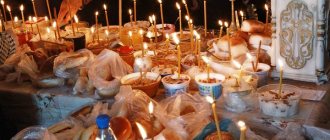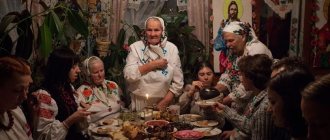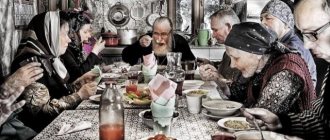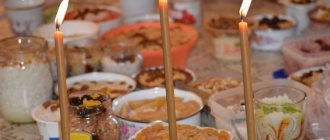Funerals are a long-standing tradition where we “see off” the deceased at a meal.
Reference! It is worth mentioning that the funeral was originally a pagan tradition, however, Christianity failed to supplant it. Moreover, it organically incorporated this tradition into its own.
Our ancestors have been performing funerals since time immemorial. Such customs can be seen in a variety of religions and denominations, among different peoples. The tradition of “seeing off” the dead is associated with the belief of many people in the soul and its immortality.
A wake does not simply mean a lunch or meal, rather it is a special ancient ritual. Its main goal is to remember a person, about his good deeds and “help” him in the afterlife.
In some regions, it is customary to enter a funeral without an invitation. Those who want to pay tribute to the deceased come, in others - strictly by invitation, without “extra” people.
General principles
Of course, the composition of the food will largely depend on the wealth of the family, the culinary traditions common in the area and on the number of people who are expected to come to the funeral. If you have the opportunity to cook everything at home with your family, you should offer those who come a simple lunch, without wasting time and effort on creating a complex menu and putting it into practice.
Funeral traditions also have their own obligatory dishes. This is, first of all, ritual kutia - porridge cooked from whole grains and flavored with honey and raisins. The funeral dinner itself should remain strict and simple, maintain mental and physical strength, and help maintain an atmosphere appropriate to the given moment. It is desirable that there be an even number of dishes, which must be consumed in a certain sequence.
When to commemorate the 1 year anniversary of death?
Often this is done exactly after a year, but there are exceptions that should be discussed with the priest. There is an opinion that the remembrance should be done a day earlier. But the priests think this is wrong. But if a major religious holiday falls on this date, then it is possible to postpone it to the next weekend. But remember that on the date of departure you need to visit a sacred place, pray and light a candle. They also recommend making a donation.
Also read: Is it possible to wear things of the deceased?
First meal
For the first course, it is customary to serve soups, cabbage soup or borscht. But since they are often prepared with meat, in the case of a funeral dinner taking place during fasting days, meat should be excluded. In addition to meat, there are several types of borscht, for example, you can prepare green borscht, regular with the addition of beans, or lean borscht with canned tomato fish. An alternative to borscht can be various soups, for example, creamy soup with mushrooms. If you prepare crispy croutons in addition to it, it should turn out even more satisfying and tasty.
Preparing for the anniversary
It is necessary to celebrate the anniversary of death correctly, because it is a summing up of earthly life. To show how dear the deceased is to us, to tell, to remember what kind of person he was. Only the prayers of living people can help the soul of the deceased reach the kingdom of heaven. It is necessary to pray for the deceased not only in the first days after death. The duty of the living is to pray for the soul of the deceased constantly, and especially diligently on memorable dates. Only our prayers can save his soul.
By this day, it is necessary to complete the installation of a permanent monument, fence, pave the surrounding area with tiles or sprinkle it with sand. In general, restore order and decorate the grave. It is very good to plant perennial flowers. Plant trees: conifers, birch, or shrubs: viburnum, lilac, thuja.
On the anniversary, be sure to visit the cemetery before lunch and bring fresh flowers. Light a candle and read prayers. You can invite a priest to conduct a service at the grave, to perform the rite of litia .
Someone reads the akathist on their own and performs a litiya, reading the 17th kathisma. Ask the deceased for forgiveness and thank him for all the good things that happened and remained in your life after him.
We bring to your attention an informative article about how services take place in the church.
Second courses
The simplest traditional second course is mashed potatoes. You can add fried fish or the same mushrooms in gravy to it. In addition to potatoes, you can prepare various porridges: rice, buckwheat or any cereals that will be combined with other products on the table. Salted fish and pickled mushrooms can be placed on the table separately. Vinaigrette and any vegetable salads, radishes will help diversify the menu. Separately, you can serve peppers, stuffed, of course, not with meat and rice, but with vegetable filling, for example, the same cabbage fried in tomato.
Cabbage or carrot cutlets, soy chops, pre-dipped and fried in breadcrumbs in vegetable oil, can adequately replace their meat prototypes. As an appetizer, you can use beetroot salad with garlic, cucumber-tomato or cucumber-cabbage salad, feta cheese with tomatoes, fresh or pickled cabbage, eggplant or squash caviar. Or use any available blanks. Soaked and salted tomatoes and cucumbers, zucchini, everything that can be grown in your garden in the summer would be quite appropriate for a funeral meal.
How to commemorate on 40 days and anniversaries
Traditionally, the funeral meal forty days after death was the most important. The special responsibility placed on relatives is to support, through remembrance and prayer, the soul of the deceased, which, according to Orthodox canons, will have to learn the decision regarding the place of further eternal residence. On the fortieth day, the soul ends its journey between earth and heaven, and appears before the judgment of God. For the last time on earth, she bids farewell to the mortal world. Kind words spoken in memory of a person, a prayer asking for forgiveness of sins, contributes to the soul of the deceased entering Paradise and eternal bliss. The most important thing that they do is pray, order Divine Liturgies and participate in funeral services. This is done after six months, and then a year after death.
On the forties, guests are gathered at the deceased’s house. Restraint and conciseness are observed in table setting and interior decoration. They remember that wakes cannot be turned into ordinary gatherings with gluttony and alcoholic libations. At funerals they eat:
- obligatory kutya and pancakes. They follow the serving sequence and eat the dishes in the established sequence, remembering their symbolic meaning: the grains will fall into the ground, germinate next year, and this will be the beginning of a new life. Eating pancakes, a semblance of the sun reborn, will give relatives hope for the resurrection of the soul of the deceased;
- After a traditional hot dish, you are supposed to serve meat or fried fish with a side dish in the form of porridge or mashed potatoes. You can add cold appetizers, herring, meat and vegetable cuts to the menu;
- salads at funerals are mostly lean: vinaigrette with beans and mushrooms, cucumbers and tomatoes, cabbage salad, carrots or boiled beets with prunes;
- jelly, compote or uzvar are placed on the table at the beginning of the meal, and at the end of the funeral dinner, oven-baked pies are served, which those present eat and take with them.
The remaining dishes of the funeral meal on fortieth, six months and anniversaries are distributed to neighbors and acquaintances who were not at the funeral.
In the modern world, one can observe how customs are erased and become a thing of the past. However, the Orthodox tradition of commemorating the dead is honored in every family.
Dough products
It is customary to end the meal with dessert. You can also cook a wide variety of dishes here. Funeral pancakes are considered obligatory. If potatoes, mushrooms and cabbage are already on the table, sweet pies made from lean yeast dough filled with apples and berries, dried apricots, and dried fruits will diversify the menu. They will be complemented by gingerbread cookies and any sweets. The choice of drinks served at a wake is berry compotes and jelly, regular or apple kvass, drinks with honey and lemon, and tea.
The hosts are advised to prepare more pastries and desserts, since at the end of dinner they are usually distributed to guests on the road so that they can remember the deceased at home with all those who were unable to attend the funeral. According to Orthodox canons, the meal should be concluded with an expression of support and sympathy for the relatives of the deceased and wishes for their well-being.
A wake is a custom of celebrating the dead with a meal. Christianity has not supplanted this custom, although priests try not to participate in it. It is considered indecent to come to a funeral without an invitation. Memorial days for 2013 can be seen. Read recipes for Lenten dishes for the funeral table in another section.
Usually the family of the deceased orders a funeral service in a cafe or restaurant, or holds a funeral service at home. After the cemetery, close relatives and friends go to the funeral.
Trizny is an ancient custom of having a meal at the grave of the deceased. They became the prototype of modern Christian funerals.
Signs for funerals and memorials
Arriving at the house, you must definitely “clean yourself” after the funeral - it is advisable to change your outer clothing, wash your hands and dry them with a towel. In Rus', a bathhouse was often heated on this day, since touching the stove was also considered a cleansing ritual. Fire - cleanses in many cults and religions.
While the procession is moving towards the cemetery, it is necessary to thoroughly clean the house and wash the floor. Pay special attention to corners in rooms, door handles, and thresholds. Then you can fumigate the room with incense or juniper.
Orthodox commemorations are, as it were, a continuation of the divine service through the consumption of food. And on the part of the family of the deceased, organizing a wake is considered Christian charity.
Funerals are also organized for 9 days, 40 days, six months, a year and on the birthday of a loved one. Triple wakes symbolize the journey of the soul to the other world. It is believed that on the third day the soul stops wandering around the house and ascends to heaven, on the ninth the body disintegrates, on the fortieth the heart decays.
Orthodox commemorations require that at the beginning someone read kathisma 17 from the Psalter in front of a lit lamp or candle. Before starting the meal, read “Our Father...”.
In Ancient Rus', certain dishes were served at funerals: kanun (fed), kutya (kolivo), pancakes, jelly. Modern housewives try to set the funeral table abundantly and variedly. Cold and hot fish and meat dishes and pies are required. If the wake falls on a fast day, you should adhere to the requirements of fasting. Below are lenten and fast dishes that can be prepared for the funeral. It is desirable that there be an even number of dishes on the table.
Modern funeral dinner and church traditions
Kanun (full) is a sweet dish made from beans with sugar or honey. Kutya (kolivo) - boiled grains with raisins, drizzled with honey. Traditionally, a funeral dinner begins with these dishes. As for alcohol at a funeral dinner, the Orthodox canons are against it, because seeing off the soul is not a place for fun. However, a modern table is rarely complete without alcohol. For the family of the deceased, this is a reason to relieve stress. That’s why you can often see vodka, cognac, and red wines. Usually during a funeral dinner they do not use knives and forks, but only spoons.
If the funeral service falls during Lent, it will be moved to the next Saturday or Sunday. All memorial days of Easter week and next Monday are celebrated on Radonitsa (Tuesday of the second Easter week).
For the deceased, a device and a glass of vodka with a piece of black bread are placed at one end of the table. Sometimes this set is left for up to 40 days.
At the end of the funeral dinner, the hosts distributed the leftover food to the guests. It is often customary to give away pastries, bread, pies to “remember” the deceased at home with those who were not present at the funeral dinner.
Below we provide a sample menu for a funeral service. If the day of the funeral dinner falls during Lent, you should choose dishes for the Lenten funeral. Menu for the funeral. Kutya
500 g rice, 200 g raisins, 200 g dried apricots, 3 tbsp. spoons of honey, salt. Cut dried apricots and soak with rice for half an hour. Boil rice in 1 liter of water, add raisins and dried apricots, honey, stir. Eat with a spoon. Everyone present must eat 3 tablespoons of kutia.
Menu for the funeral. Homemade noodles
4 legs or whole chicken, carrots, salt, pepper, dill, bay leaf.
Make homemade noodles from 0.5 kg of flour and 3 eggs. Roll out the dough thinly, let dry and cut. Boil the chicken, strain the broth, chop the meat into small pieces. Chop the carrots and put them back into the broth. Before starting the feast, the noodles should be dipped in chicken broth. Add salt and spices.
Menu for the funeral. Lenten borscht
It is prepared like regular borscht, but the broth is prepared without meat.
Cook the beans, add chopped potatoes and cabbage. Make a fry of carrots, onions, beets, and tomato paste. Add to broth. Cook for 10-15 minutes, add spices, pepper, salt, garlic.
The borscht should be allowed to brew. Therefore, it must be prepared in advance before the funeral dinner.
Menu for the funeral. Pancakes
The obligatory presence of pancakes in the funeral dinner has been preserved since pagan times, where they symbolized the sun, that is, the idea of eternal life.
4 eggs, 3 cups flour, 1 liter of milk, sugar, salt, a little soda, vegetable oil for frying.
Mix all ingredients, let the dough stand for 15-20 minutes. Vegetable oil can be added to the dough so as not to grease the pan. Bake thin pancakes, grease with butter.
Funeral lunch menu. Lenten pancakes
Make a batter from 2 cups of flour, warm water, dry or fresh yeast, add salt and sugar, vegetable oil so as not to grease the pan before each new pancake.
Funeral lunch menu. Lenten bun
From the proposed set of products you will get about fifty buns. 2 kg of flour, 1.1 liters of water, a packet of yeast, 300 g of sugar, 1.5 teaspoons of salt, 50 ml of vegetable oil.
Dissolve sugar and yeast in warm water, let rise a little, add salt and flour, pour in vegetable oil. Wait until the dough doubles in size, form small buns and place them on a baking sheet at a distance from each other and leave for another half hour. After this, bake in the oven at 220 C for about 20 minutes. The finished buns can be greased with sugar syrup. You can use the same dough to bake pies with jam or berries.
The dishes for the funeral dinner are simple: cutlets, fried fish, chicken, meat. As side dishes, you can choose mashed potatoes or buckwheat or rice porridge. At the end of the meal, it is customary to serve jelly or dried fruit compote.
Read how to bake traditional “ladders” for a funeral.
Every person in life is faced with the loss of a loved one who needs to be remembered and honored throughout his life. The menu for a funeral must, first of all, comply with the religious norms of the deceased. In addition, each dish must be prepared with high quality, so choosing a good establishment is a responsible step.
Our complex offers its own organization of such an important event. We offer menus for 40 days of funerals and other important dates. Our variety of offerings will suit any budget. For example, you can choose a menu for 700 rubles per person if your budget is small.
What to commemorate in Lent
The passing of a loved one can happen during the period of fasting. Relatives cannot cancel their duty both on the ninth and fortieth day after death for the sole reason that ordinary dishes cannot be prepared.
During Lent, the deceased is remembered in accordance with the traditions of Orthodox spiritual culture, but adjustments are made by excluding certain ingredients that are not eaten at this time.
The menu for a memorial lunch during Lent is special. Kutya is prepared without adding butter. Water is added to the pancake batter instead of milk and no eggs are added. The rest of the treats can also be prepared Lenten and a ritual meal can be organized at a decent level.
Main courses should not contain meat, but can be no less tasty if you select the right products and follow the cooking technology. From generation to generation, housewives pass on the recipe for the original Russian Lenten borscht, which, according to Orthodox tradition, is quite appropriate for commemorating the dead. No less popular are cabbage soup with mushrooms, buckwheat and sauerkraut. You can prepare vegetable salads, seasoning them with vegetable oil; serve lean cabbage rolls or stuffed peppers with mushroom sauce or carrot meatballs as a side dish of potatoes. Guests will enjoy cabbage pie, pies stuffed with potatoes, onions and herbs, and fruit slices.
When preparing a menu, the most important rule is to maintain restraint and modesty. Those who plan a luxurious meal with alcoholic drinks do not fully understand the meaning of the commemoration. The deceased needs the prayers and remembrance of loved ones more to ease the transition to the afterlife than a funeral dinner with plenty of food and drink. Maybe that’s why no one is invited for 9 days, but those who come are sure to be seated at the table and treated to food.
Why choose us?
If you have not yet made your final choice in favor of any institution, then you should definitely find out about our advantages:
- For all customers we provide the best offers in terms of price and quality in the city. You can order different menus for the 9-day funeral. A popular option is the menu for 1000 rubles per person. The price includes all food and drinks required by the religion;
- We do not oblige the customer to purchase alcohol from us. Everyone can purchase alcohol on their own and bring it to the funeral. We do not charge extra for our own alcohol;
- Our team has the best service staff. Each employee understands the importance of such an event, therefore they provide services at the highest level;
- To organize funerals, we offer our clients three halls. They differ in design and capacity. The customer can choose what suits his wishes and requirements.
The funeral menu is selected in advance upon first contact and approval of the order. An excellent option would be a menu for 1200 rubles per person.
A day earlier or later: is it possible?
You need to order a memorial service in the church for a year.
Is it possible to postpone the funeral? Perhaps this is the most exciting question. After all, it often happens that a memorable date falls on weekdays, when it is difficult to carry out the commemoration as one would like. Can this be done earlier or, conversely, postponed to a later date? Be that as it may, the best way to remember the deceased in church is day after day, pray for him, light a candle, make a feasible sacrifice, and the organization of a memorial dinner depends on the temporary capabilities of the relatives.
The Church does not regulate the time during the day when the deceased can be remembered.
There are traditions dating back to paganism, the so-called folk ones, which have nothing to do with Christianity. You just need to remember that the Creator is outside of time and space, and you can offer prayers to Him at any moment of life.
By the way, the annual date may fall on a religious holiday, then the clergy recommend postponing the commemoration to another time, to the next weekend - either a little earlier or later than the memorable date.
As for the holiday of Easter and Bright Week, on these days, which are days of joy and not sorrow, funeral services and memorial services are not performed. The most logical thing in this case is to move the wake, including the memorial table, to Radonitsa, a church-wide memorial day. And on the Feast of the Resurrection of Christ itself, it is very good to give alms for the deceased.
Menu for 1200 rubles per person
| Cold appetizers | ||
| Assorted fresh vegetables | 50 gr. | |
| Herring with potatoes | 50 gr. | |
| Assorted homemade pickles | 50 gr. | |
| Assorted meats | 50 gr. | |
| Kutya | 50 gr. | |
| Pancakes | 2 pcs. | |
How do we work with our clients?
We work with each client in four stages. The first stage is for a person to contact our company. You can call yourself or leave a request for a call on our website. During the first conversation, you can clarify all the details you are interested in. For example, what menu do we offer for funerals 40 days and other dates.
At the second stage, the customer comes to our complex to get acquainted with the halls. In the process, he can choose what suits him. Can also indicate some wishes for textile design. At the third stage, the order is confirmed: the hall is selected and the menu is determined. If you have a larger budget, you can choose a menu for 1,500 rubles per person.
What do they order at church?
Since there is a custom of going to church, it is worth knowing what to order in church for the anniversary of death. To submit a note for remembrance during the Divine Liturgy, you must do the following:
- come early in the morning before the service;
- write a note asking for mass;
- pass it on to the candle shop;
- indicate the full name of the deceased.
After the service, return home with prosphora and eat it in memory of the deceased. Others give a note on magpie and place a candle for the forgiveness of sins. If for some reason the funeral cannot be held on a certain day, then mass can be ordered a week later.
Menu for 1500 rubles per person
| Cold appetizers | ||
| Assorted fresh vegetables | 50 gr. | |
| Cucumbers, tomatoes, sweet paprika, greens | ||
| Herring with potatoes | 50 gr. | |
| Herring, pickled onion, potato | ||
| Assorted homemade pickles | 50 gr. | |
| pickled cucumbers, pickled cherry tomatoes, gherkins, sauerkraut | ||
| Homemade jelly | 50 gr. | |
| Assorted meats | 50 gr. | |
| Homemade boiled pork, beef tongue, chicken roll with garlic and herbs | ||
| Kutya | 50 gr. | |
| Traditional funeral porridge with raisins and honey | ||
| Pancakes | 2 pcs. | |
The final stage is holding a funeral at a high level. It doesn’t matter what you choose: a memorial menu for a 9-day funeral or other options, we will do our job at the best, all guests will be satisfied.
We remember at home
Commemoration of the dead is impossible without prayer. Not everyone led a righteous life, and their souls may experience terrible torment. Only through intense prayer to the Lord can we help these restless souls find peace. And the prayer appeal to God on a sad anniversary should be special.
Most often, a memorable date follows a certain scenario:
- Funeral service at the cemetery. relatives determine in advance where and how the funeral table will be organized;
- all close friends of the deceased are invited to the funeral;
- a lithium or memorial service is ordered in the church;
- alms are distributed to those in need;
- after the service, loved ones go to the cemetery, light a candle on the grave, lay flowers, and read a prayer;
- It all ends with a funeral meal.
It is important
The meaning of the icon of the Mother of God “Unfading Color” and how it helps
Where is the “Increase in Mind” icon located and how does it help?
The meaning of the Seven Arrows icon and how it helps
How does the “Inexhaustible Chalice” icon help and its meaning?
What does the icon of the Mother of God “Helper of Sinners” help with, its meaning
What is a proskomedia about health or repose?
What does the icon of the Mother of God “Gracious Heaven” mean and what does it help with?
Cost of unction: how much it costs in church and at home
What you can and cannot eat and do before communion
Saint Paraskeva Friday from Iconium
The meaning of the icon of the Mother of God “Joy of All Who Sorrow”, what they pray to her for
How does Archangel Michael help?
Is it considered a sin to drown kittens: answers from priests
What does the icon of the Most Holy Theotokos “Tenderness” help with, its meaning
After unction: how to behave, what to do with oil and candle
What does the “Unexpected Joy” icon help with and its meaning
Troubles, what does Saint Olga, the patroness, help with?
How does the holy martyr and wonderworker Tryphon help?
How to commemorate 1 year from the date of death
How does the holy healer Panteleimon help?
Who does Archangel Gabriel favor and help with?
What is adultery in Orthodoxy
The meaning of the icon “Faith, Hope, Love and their mother Sophia” and how it helps
Going to church during menstruation: is it possible or not?
The meaning of the icon of the Mother of God “The Burning Bush” and how it helps
What do they pray for to the Mammal Icon?
How does the Holy Family icon help and what does it mean?
How to sprinkle an apartment with holy water
How to choose godparents for a child
Powerful prayers for work
How to order a magpie about health and the text of a prayer to read at home
About the Tikhvin Icon of the Mother of God: what helps, meaning
The meaning of the icon of the Mother of God “Quick to Hear” and how it helps
Rules for washing a child from the evil eye with holy water and washing yourself
What does akathist mean and how to read it correctly
Is female or male masturbation considered a sin?
What Luka Krymsky protects from and what helps with
Pochaev Icon of the Mother of God: what it helps with, what is its significance
The meaning of the icon of Saints Peter and Fevronia and how it helps
Wedding questions: is it possible to get married without registration, pregnant and others
What properties does holy water have and why does it not spoil?
Prayer for selling and buying a house or apartment
The meaning of the “Unbreakable Wall” icon, and how it helps
What does the “Three-Handed” icon help with and its meaning
Is it possible to drink holy water just like that and how can you do it correctly?
Notes on health and repose: how to write correctly plus a sample
Vladimir Icon of the Mother of God: what it means, what it helps with
How to use Orthodox rosaries and their meaning
Who does Archangel Uriel help and with what?
What helps and what is the meaning of the Burning Bush icon
Why does holy water turn green at home, bloom or become rotten?
Pros and cons: is it possible to baptize without godparents
What is money-grabbing, foul profitability and covetousness in Orthodoxy?
What does Spiridon Trimifuntsky help with?
How does the Holy Great Martyr Catherine help?
How does the Holy Archangel Raphael help?
When to order a magpie for the repose and how to do it correctly
What do they pray for in the “Seeking the Lost” icon, what does it mean?
Prayers for the quick sale or purchase of a car
Who to pray for a quick and successful marriage: strong prayers for girls and mothers
How to Use Holy Water: Do's and Don'ts
The meaning of the icon of the Mother of God “The Tsaritsa” and how it helps
Strong prayers for family quarrels
Recommendations on what to do with old holy water
Prayer service: what is it in simple terms
Proper preparation for unction
Godparents: rules and responsibilities
How does the Holy Trinity icon help and what is its meaning?
The meaning of the icon of the Mother of God “It is worthy to eat” (“Merciful”) and how it helps
How does the Holy Great Martyr Barbara help?
What prayer to read before and after surgery
Is it possible to remember 40 days earlier or later and how to do it correctly
9 days from the date of death: how to remember
Next
Prev
The opinion of the Orthodox Church
The Orthodox Church supports the idea of a commemoration on the anniversary of a person’s death, but notes that many traditions and canons are violated by people, which distorts the main principles. Relatives should remember that the most important moment is prayer for the deceased, and not the feast or even cleaning the grave. Both of these aspects also play a role, but not the main one.
Clergymen often point out that wakes do not involve the consumption of alcohol. People explain the presence of vodka and other strong drinks on the table with the desire to drown out the grief of loss. On the one hand, this is logical, but on the other, it has nothing to do with Orthodox traditions and is interpreted as blasphemy. In memory of the deceased, you need to order a service, pray, and not make toasts.
In general, representatives of the clergy note that modern commemorations on the anniversary of death are a combination of Christian and pagan traditions that existed in Rus' even before its baptism. In this regard, the attitude of the church towards many rituals is ambiguous, and towards some it is acutely negative. The family should decide in advance whether the funeral will take place according to Orthodox traditions or according to the canons accepted in society.
The anniversary of death is one of the memorial days indicated in Christian books. It is believed that the eternal life of the soul begins with it. On this date, it is customary to pray for the deceased, visit the cemetery, church and set the table. The event is of a narrow family nature and does not involve inviting unfamiliar people.
Recipes for Lenten dishes for funerals
Anyone can prepare simple dishes for a funeral table, regardless of culinary abilities or religiosity. The main thing is to do this with good thoughts and a bright memory of the departed person.
Lenten recipes
Rice kutia with dried fruits
Cereals and dried fruits should first be rinsed and soaked in water for a while. Then put the rice on low heat and cook, stirring, for about 20 minutes. After this, drain the remaining water and rinse the rice. You can add dried fruits, honey and poppy seeds cut into pieces (optional) to the finished porridge. The same preparation procedure should be followed if kutia made from wheat cereals is served at the funeral table.
Preparation of funeral kutia
Lenten pancakes and pies
The recipe should not contain milk or eggs , which means the dough is made from flour, yeast, sugar and salt. All this should be diluted with warm water, add a little vegetable oil and leave for a while until the dough is ready. The dough for Lenten pies can be prepared using the same principle, choosing any vegetables, berries or dried fruits for the filling.
Cooking Lenten Pancakes
How is the funeral dinner going?
The table is set with dishes that are used every day. Cutlery is placed for the deceased. Those who come to commemorate sit down, taking into account the distance of relationship. The closest relatives are placed next to the device of the person who has passed into the other world.
Having arrived from the cemetery, everyone must wash their hands and, after that, sit down at the table. While at the funeral table, you need to behave quietly and modestly. After eating, the guests leave without saying goodbye. The remaining food is distributed to those invited so that they can remember the deceased at home.











